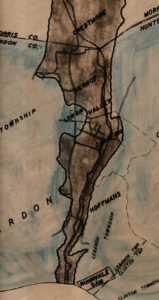Collection Gems: September 2018

Did you ever wonder what Hunterdon County might have looked like if others had their way? Hunterdon County has often been eyed covetously for its abundant water resources. The result? Round Valley and Spruce Run reservoirs, created in 1960 and 1964, respectively. For the record, the Wanaque Reservoir was created in 1928 and is the second largest in New Jersey, smaller than Round Valley. But what about the Bunnvale reservoir? It was proposed but never undertaken. What and where was this project? The Society’s Map 28 (Figure 1) can help!

As John mentioned in his article, the Great Depression rendered the project financially unattractive. But the proposal was resurrected in 1948 with the “primary purpose… to meet the prospective water supply requirements of metropolitan areas, within and without the Basin, in the States of New Jersey, New York and Pennsylvania”. The Interstate Commission on the Delaware River Basin (Incodel) was created to “promote interstate cooperation for the conservation and protection of water resources of the Upper Delaware River Basin” for the benefit of the populations of the three named States. Almost 21,500 acres of Hunterdon County would have been submerged, including much of Lebanon Tewksbury and Clinton Townships and the Borough of Califon (Figure 2, rotated counterclockwise). Important to the proponents of the reservoir were the fact that these areas were characterized by lower population densities than some other areas, so tax revenue would not be significantly affected should these 2000 people be displaced if the area proposed was flooded to create the reservoir. In the end, alternative projects were found to be more attractive and the Bunnvale reservoir site was found to have some unattractive aspects (a likely permeable substrate, for example) and was never undertaken.

It needs to be remembered that this population figure predated the post-War boom and the Interstate Highway system that resulted in significant growth of the area; so significant that the Highland Act of 2004 was enacted to (among other things) slow its population growth. Northwestern Hunterdon County would have been a very different place had the reservoir been created, flooding the areas shown graphically in Figure 2 and tabulated in Figure 3.
